
This is truly heart-warming—wonderful acts of human kindness as recorded from across Russia by dashboard cameras.
Via reddit - with thanks to Tara!

This is truly heart-warming—wonderful acts of human kindness as recorded from across Russia by dashboard cameras.
Via reddit - with thanks to Tara!

Fragments from a meteor explosion over the Chelyabinsk region of Russia, approximately 920 miles to the east of Moscow, injured up to 500 1000 people, as windows were shattered, tiles fell, and the roof of factory collapsed.
The meteor has been estimated to have weighed around 10 tons and its explosion lit-up the sky with a massive flash of light, leaving an enormous plume of smoke.
According to the first news reports, Vadim Kolesnikov, a spokesperson for the Russian Interior Ministry, said 102 people had called emergency services for medical assistance following the incident—mostly for multiple injuries caused by broken glass and falling objects. This figure has now risen to over 520 1000, and includes dozens of children, and 2 that are currently in intensive care.
Footage of the explosion has been variously captured by cell phones, CCTV and on-board car cameras.
View a selection of photographs at the Guardian.
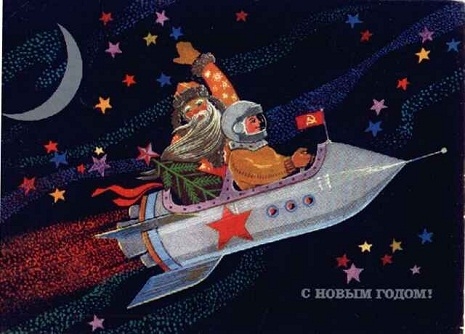
Despite adopting a policy of state atheism, the secularization project of the Soviet Union could do nothing to sever the cultural connection to Christmas.
Below are some “holiday” cards from the Soviet era, but one can easily detect efforts at sneaking familiar Christmas traditions into what had become a Soviet New Year celebration. You can see the character of Ded Moroz, formerly an evil sorcerer from Slavic mythology—he was said to freeze and kidnap children without conciliations from their parents. His striking resemblance to Santa is the result of a massive rebrand by the Orthodox Church to mimic the Dutch Saint Nicholas.
Of course, after the Russian Revolution, Ded Moroz was declared “an ally of the priest,” and was subsequently (somewhat awkwardly) retrofitted over the Soviet New Year holiday. In 1935, high-ranking Soviet politician (and primary facilitator of the famine-genocide in the Ukraine), Pavel Petrovich Postyshev spoke out in defense of Christmas, arguing that its pre-Christian origins and value to children should exempt it from condemnation as bourgeois or religious. This paved the way for a more lenient view on the holiday.
In 1937, Stalin even commissioned a Ded Moroz for public appearances, commanding, however, that they wear blue, so as not to be conflated with the Western Saint Nicholas. There were even Soviet Nativity Scenes with Ded Moroz as Joseph, a Snow Maiden (Ded Moroz’ helper) as Mary, and the baby New Year as Jesus.
As you can see below, Soviets fashioned some truly surreal feats of cultural synthesis with Ded Moroz, Communist iconography, and the USSR’s omnipresent symbol of ambitious futurism: space travel.

Rockets for speed, horses for nostalgia

Actually, screw the vestigial horses—they’re just bourgeois sentimentality

Note the icons of industrial economy in the tree—factory, bridge, dam, rocket, minecart, etc
More after the jump…

Despite the perception of the USSR as a colorless model of utilitarianism, when we get a peek at some of the stuff it produced, we find all sorts of innovative artifacts. The Museum of Soviet Arcade Games resides in the basement of an engineering school in Moscow. Run by Maxim Pinigin and Alexander Stakhanov, it contains about 20 working machines, with 20 more under repair. The pair run the museum as a functioning arcade, open to the public, seven days a week.
The game above is called Morskoi Boy, literally “Sea Battle.” Of course, being Soviet, it was was government-produced, making use of national manufacturing. So, it was actually made in a submarine factory, and the periscope is an actual submarine periscope. While presumptuous American minds frequently ask if this was some sort of Cold War training machine, Pinigin and Stakhanov insist that the game was just for fun and entertainment.
In fact, like a lot of Soviet arcade games, Morskoi Boy is a direct knock-off of a (decadent) American console, (though with a heaping helping of Soviet charm). This is all the more surreal when you consider the omnipresence of The Cold War; the kids who played Sea Battle in the U.S. could have very well been imagining Russians manning the ships they torpedoed, all the while Russian kids were playing the exact same game, perhaps fantasizing Americans as their targets.
If you can’t make it out to Moscow, the video below shows the game in action, and the website has a fun (and addictive) flash facsimile. So go shoot some battleships! Just try not to think too hard about who you’re shooting at.
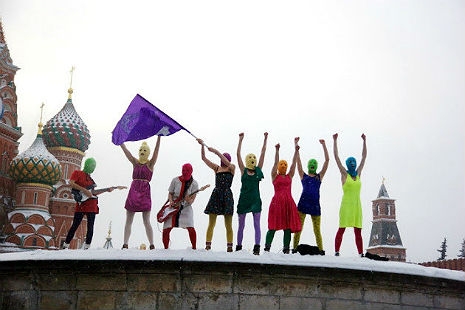
Two members of the Pussy Riot feminist art collective have fled from Russia to avoid prosecution for the same protest against Vladimir Putin that landed three of their fellow band mates two-year prison sentences. This according to the AP report and the Pussy Riot Twitter feed:
Five members of the feminist group took part in a provocative performance inside Moscow’s main cathedral in February to protest the Russian leader’s rule and his cozy relationship with the Orthodox Church. The women wore their trademark garishly colored balaclavas, which made it difficult for police to identify them, and only three were arrested.
After a controversial trial that highlighted Putin’s crackdown on dissent since he began a third presidential term in May, the three band members were convicted of hooliganism and sentenced to two years in prison on Aug. 17. Days later, Moscow police said they were searching for the other band members, an apparent warning to the group to stop its anti-Putin protests.
Even as the judge was reading the verdict in a Moscow courtroom, one of the band members who had escaped arrest played Pussy Riot’s latest song, “Putin sets the fires of revolutions,” from the balcony of an apartment building across the street.
Pussy Riot tweeted on Sunday that the two activists had fled Russia and are “recruiting foreign feminists to prepare new protest actions.” No mention was made of where they went.
Can’t say I blame them for wanting to keep mum on that count!
An essay appeared in The Moscow Times today arguing that the political art/punk pranksters have roots to earlier counterculture movements and strains of Russian political dissent going back to the 19th Century. Peter Rutland writes:
Much more interesting than the band’s antics in the cathedral, however, were the closing statements that the three defendants delivered to the court, which New Yorker editor-in-chief David Remnick described as “a kind of instant classic in the anthology of dissidence.” Each woman took a different theme. Yekaterina Samutsevich dissected the unhealthy fusion of church and state. Maria Alyokhina talked about the deficiencies of the country’s education system and the suppression of the individual. Nadezhda Tolokonnikova offered a critique of the “autocratic political system” in general and the conduct of their prosecution in particular.
The statements portray a society that is passive and disoriented in the face of an all-powerful ruling bureaucracy. Their critique is spiritual rather than material, and they are not particularly interested in leveling accusations of corruption, which have been the central theme of the mainstream opposition.
Many Russian observers have been dismissive of Pussy Riot, characterizing their provocative actions, including previous performances of a sexual nature, as infantile and offensive — and unpopular with the public at large. But it is not at all clear whether Pussy Riot expects or even desires a groundswell of public support. They do not aspire to be leaders of a revolutionary movement, either Orange or Leninist.
Rather, their appeal for truth and freedom puts them squarely in the tradition of the 19th-century Russian intelligentsia. Tolokonnikova directly referred to the group’s punk antics as equivalent to the truth-telling “holy fools” of centuries past and embraced the idea that their prison sentence proves the virtue of their cause.
Pussy Riot adopted the tactics of protest from the Situationists of 1960s France, the punk rockers of 1970s Britain and the feminist Riot Grrrls in the United States in the 1990s. The idea of donning masks comes from the movie “V for Vendetta,” which was popularized by the Occupy movement.
But the strategy of Pussy Riot has a deeper foundation. Their moral critique of authority and appeal to a higher truth is rooted in pre-revolutionary Russia, a tradition that fitfully resurfaced during the Soviet years. They cite 19th-century literary critic Vissarion Belinsky and Fyodor Dostoevsky, but not Voltaire, John Stuart Mill or other representatives of the Western liberal tradition.
The assertion of an individual’s right to exist — what Alyohkhina refers to as “inner freedom” — is not a problem for young people living in the West and has not been for a century or more. Whatever the shibboleths that are evoked by today’s Western radicals — such as capitalism, neoliberalism, Empire and racism — they are phenomena quite different from the challenge posed by the authoritarian Russian state.
There are at least twelve other members of the Pussy Riot collective who still remain in Russia.
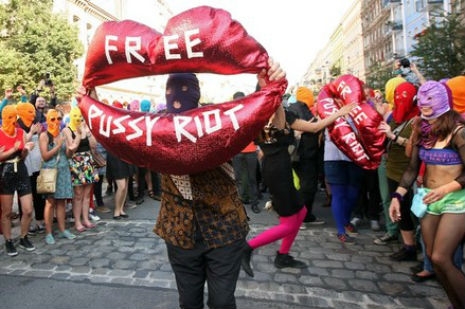
When it comes to feminist-punk, there’s none more femme, nor punk, than the mighty Peaches.
So it’s no real surprise to learn that Peaches has been following the Pussy Riot trial closely, and has turned her hand to making both a video and a track in support of the persecuted Russian rock group.
A YouTube casting call went out last week, asking for fans to send in their own, pro-Pussy Riot footage to be included in the video. Well it is now done and dusted, and available to watch online. The track itself, called “Free Pussy Riot”, is available as a free download, and all Peaches is asking in return for her work is that everyone sign the Free Pussy Riot petition at change.org.
This is the statement Peaches and friends have made to go with the download:
Peaches, Simonne Jones, and tons of musicians, artists, activists, and free-thinkers are came together to make a video for this song in support of the russian punk feminist band PUSSY RIOT! Now that you have heard about the song and video, we want you to take action! Here is why:
In March 2012 three members of Pussy Riot, Maria Alyokhina, Nadezhda Tolokonnikova, and Yekaterina Samutsevitch, were taken into custody by Russian authorities for their participation as part of a protest at the Cathedral of Christ the Saviour of the Russian Orthodox Church in Moscow. Their punk prayer is and was an act of free speech and the charges of “hooliganism” and detainment of the three women are seen by the world as a cruel heavy handed act of oppression, are being carried out to discourage free thought and speech in Russia.
If Russia wishes to be a part of the modern globalized world it must adhere to the standards and principles of a free nation where its people have the right to have a free and open dialogue about all subjects. Discussion, debate, and action are the basic building blocks of a free society. By following through with the prosecution of these women Russian political bullies are currently making a mockery of free speech, free thought, and Russia’s own country’s constitution.
We, the citizens of the world and advocates for free speech, DEMAND the immediate release of Pussy Riot. The verdict is planned for August 17th - let’s show Pussy Riot our support!
The charges and punishments facing Maria, Nadezhda, and Ekaterina are nothing more than a political stunt by the Russian authorities and Russian Orthodox Chruch to retain control over the Russian people and instill fear into the free-thinkers, political activists, and artists of Russia.
The world is watching, and we do not like what we see.
I do, however, like what I see here:
Peaches “Free Pussy Riot!”
And here is the track itself:
Free Pussy Riot by Peaches Rocks
You can sign the Free Pussy Riot petition at: www.change.org/freepussyriot
Donations are also accepted at: http://freepussyriot.org
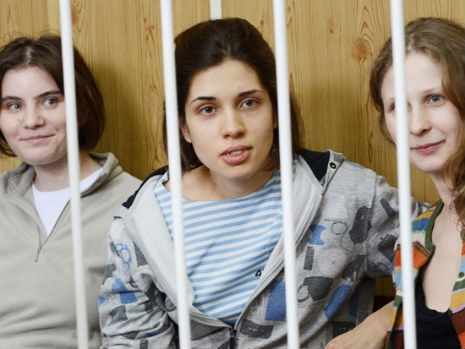
Björk has posted a ‘statement in defense of Pussy Riot’ on her website:
dear folks
here comes a statement in defense of pussy riot :
as a musician and a mother i would like to express i fiercely dont agree with them being put to jail because of their peaceful protest performance . they are currently standing trial and facing seven years in prison for this .
in my opinion the russian authorities should let them go home to their families and children
i would like to invite pussy riot to join me in a particular song on stage : which was written for all enhancement of justice ( you can guess : once , which one )warmth , björk
Help free Pussy Riot here.

An extraordinary essay by Pussy Riot member Nadya Tolokonikovoy has appeared on the Free Pussy Riot website. You can follow a blow by blow description of what is taking place at the Pussy Riot trial on Twitter. Kafkaesque? It’s that in spades, see for yourself. I thought it was important for this to be read by as many people as possible, so I am reproducing it here in full (but not block quoting it, because it would be a mile long)—RM
Art and the Human Manifesto of Nadya Tolokonnikova
The punk band Pussy Riot, which I belong to, is a musical group that conducts unexpected performances in different urban spaces. Pussy Riot’s songs address topical political issues. The interests of the group members are: political activism, ecology, and the elimination of authoritarian tendencies in the Russian state system through the creation of the civil society.
Since its origin in October 2011, the band played concerts in the subway, on the roof of a trolleybus, on the roof of the detention center for administrative detainees, in clothing stores, at fashion shows, and on the Lobnoe Mesto on Red Square. We believe that the art should be accessible to everyone; therefore we perform in diverse public spaces. Pussy Riot never means to show any disrespect to any viewers or witnesses of our punk concerts. This was the case on the roof of the trolleybus and on the Lobnoe Mesto, and this was the case at the Cathedral of Christ the Savior.
On 21 February 2012 Pussy Riot band performed its punk prayer “Hail Mary, Expel Putin” at the Cathedral of Christ the Savior. In the early March 2012 three members of the group were imprisoned because of the music and political activism. The themes of our songs and performances are dictated by the present moment. We simply react to what is happening in our country, and our punk performances express the opinion of a sufficiently large number of people. In our song “Hail Mary, Expel Putin” we reflected the reaction of many Russian citizens to the patriarch’s calls for vote for Vladimir Vladimirovich Putin during the presidential election of 4 March 2012.
We, like many of our fellow citizens, wrestle against treachery, deceit, bribery, hypocrisy, greed, and lawlessness, peculiar to the current authorities and rulers. This is why we were upset by this political initiative of the patriarch and could not fail to express that. The performance at Cathedral of Christ the Savior was committed not on the grounds of religious enmity and hatred. Equally, we harbor no hatred towards Orthodox Christians. Orthodox Christianity worships the same as we do: mercy, forgiveness, justification, love, and freedom. We are not enemies of Christianity. We care about the opinion of Orthodox Christians. We want all of them to be on our side - on the side of anti-authoritarian civil society activists. That is why we came to the Cathedral.
We came with what we have and can: with our musical performance. During this performance we intended to express our concern: the rector of the Cathedral of Christ the Savior and the head of the Russian Orthodox Church - the patriarch - supports a politician who forcefully suppresses the civil society, which is dear to us.
I would like to emphasize the fact that, while at the Cathedral, we did not utter any insulting words towards the church, the Christians, and the God. The words we spoke and our entire punk performance aimed to express our disapproval of a specific political event: the patriarch’s support of Vladimir Vladimirovich Putin, who took an authoritarian and antifeminist course. Our performance contained no aggression towards the audience, but only a desperate desire to change the political situation in Russia for the better. Our emotions and expressiveness came from that desire. If our passion appeared offensive to any spectators, we are sorry for that. We had no intentions to offend anyone. We wish that those, who cannot understand us, would forgive us. Most of all, we want people to hold no grudges against us.
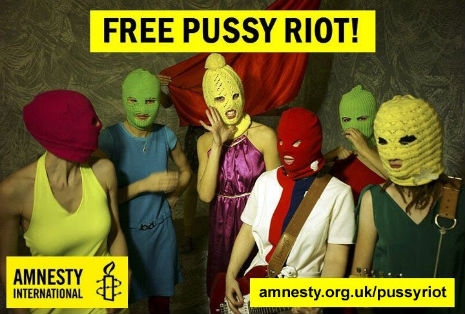
How big a dickhead is President Vladimir Putin?
Well, we’ll soon find out, as three members of Feminist Punk Rockers, Pussy Riot went on trial today, charged with “hooliganism motivated by religious hatred.”
Their crime? Performing an anti-Putin, anti-religious song at the Christ the Saviour Cathedral, Moscow, in February this year.
It was a moment of shock political theater, as the band stormed the altar while shouting “Mother of God, Blessed Virgin, drive out Putin!”
Now, Nadezhda Tolokonnikova, 22, Yekaterina Samutsevich, 29, and Maria Alekhina, 24, face up to 7 years in jail for their actions.
These women have been detained since March, without access to their families or possibility of parole. Russian opinion is divided over the arrests, but there have been major protests across Moscow in support of Pussy Riot.
However, it is feared Pussy Riot won’t get a fair trial, as Putin is the real force behind the prosecutions. Nikolai Polozov, one of Pussy Riot’s defence lawyers, told the Daily Telegraph:
“They went on to Putin’s sacred ground and he’s a vengeful person. I’m sure he gave the signal for this prosecution.”
Mr Polozov said he expected a guilty verdict but could not predict the sentence. “It could be two months, it could be seven years,” he said.
“If Putin is under pressure, say on Syria, or something else happens, he might use the girls as a distraction and earn some political capital by putting them away. And then they’ll be sewing felt boots, like Khodorkovsky, in a prison colony.”
Amnesty International are currently organizing a campaign to Free Pussy Riot:
Today marks the start of Nadezhda, Maria and Ekaterina’s trial. It’s been a long time coming: they’ve been held in Moscow police cells since their arrest in February, denied access to their families – including their young children.
Last week, the Moscow City Court ruled to extend their detention by another six months on the grounds that the women committed a serious crime, and may abscond if granted bail.
You can help Pussy Riot by clicking here, or here.
Previously on Dangerous Minds
Pussy Riot: Russian riot grrrls lead the way
Bonus clips of Pussy Riot’s “shock” performance plus news report, after the jump…
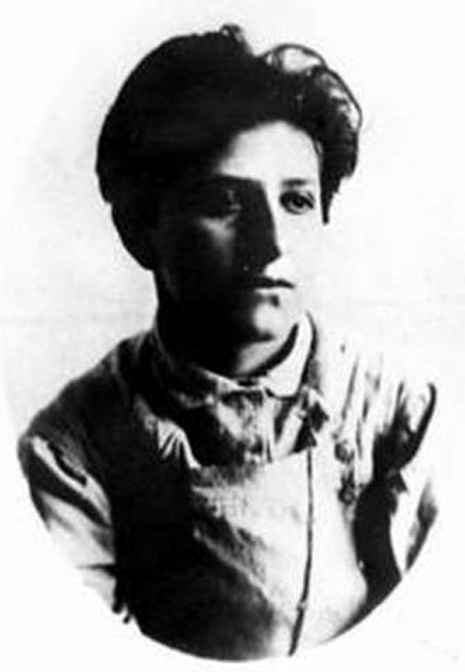
This is a guest post by Zoetica Ebb, a Moscow-born, LA-based artist, writer, photographer and style technician. Follow her on Twitter @zoetica.
Read Part I of Ghosts of the Moscow Kremlin.
Fanny Kaplan lived her turbulent life in the early 20th century. A young Jewish anarchist in Kiev, she partially lost her sight at the age of twenty, during preparations for a terrorist action, when explosives accidentally detonated. Arrested while trying to flee the scene, she was sentenced to death. Because Fanny was under twenty-one, she was sent to a labor camp instead, where she spent most of her time in ill physical and mental health, eventually losing her vision entirely.
When the Revolution of 1917 came, she was released. Free again, Fanny underwent a series of treatments and her vision partially returned. She joined an anti-Marxist socialist party and, one year later, was arrested for the attempted assassination of Lenin, who was shot three times at a large-scale meeting. In a considerably shady turn of events, she was captured by the militia holding a gun and saying, “I did my duty.”
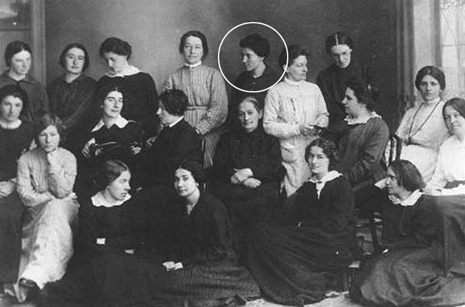
Considering Fanny’s impaired vision -at this time she could only make out shadowy shapes- and the fact that the well-aimed bullets weren’t extracted from Lenin to be checked for a match to her pistol, this confession was dubious (also see: Lee Harvey Oswald). Nonetheless, since she wouldn’t name any accomplices, Fanny Kaplan was executed at the Kremlin without a trial or an investigation three days later. She was shot and stuffed in a barrel, which was then set ablaze, leaving no room for confusion in least in one aspect of her story, making her a perfect candidate for eternal unrest.
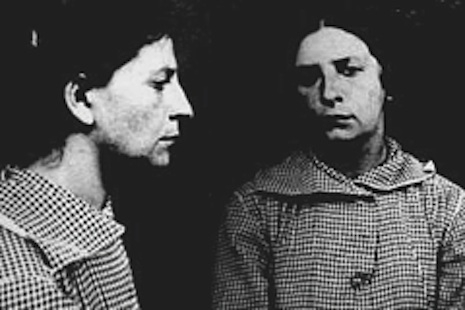
A pale, trembling Fanny with uncombed hair and a gun is sometimes seen inside one of the Kremlin towers to this day.
Vladimir Ilyich Lenin remains an iconic figure in Russian history, though national reverence and enthusiasm have waned since the fall of Communism. As someone who grew up during Communism’s final decade, I still find Lenin difficult to write about, since the shiny dogma we were taught in school and the details surfacing over the past twenty years are at considerable odds. Even so, his accomplishments are many and his work ethic alone is awe-inspiring, even if all of his ideals and doings were not.

He was the erudite revolutionary who fought the Great Civil War, helped overthrow the last tzar and built an entirely new government, transforming Russia into a Soviet State with a socialist economic system. He worked sixteen-hour days until his death, wrote entire books without the help of a stenographer, all the while managing to maintain communication with friends and allies. His pamphlets, reforms, and long, impassioned speeches before huge crowds made him into a national hero. Despite being a slight man with unremarkable looks, the propaganda spun by Lenin’s eventual successor, Joseph Stalin, inflated his newly broad-shouldered and strong-jawed image to near-leviathan proportions. After decades of his trademark hostile intolerance toward faith, which dubbed religion “a mass opiate to be eradicated”, Lenin became god. Stalin continued to cultivate this personality cult to legitimize himself during and well after Lenin’s lifetime.
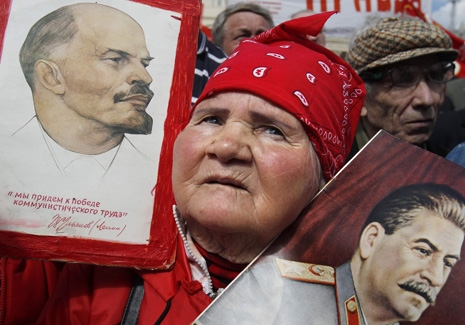
Before he eventually worked himself to death in 1924, Lenin fell gravely ill, and, partially paralyzed, was ordered rest at his summer house outside of Moscow. Shortly before his end, a Kremlin security chief saw what appeared to be Lenin walking briskly through the corridor up to his former apartment on the premises. Confused by Lenin’s lack of cane and entourage, the chief made a call – only to confirm that Lenin was at the summer house, resting as prescribed. Numerous similar eyewitness accounts followed, in direct opposition with the anti-spiritual doctrine of the times. The matter was quickly covered up with a false story of Lenin visiting Moscow one last time.
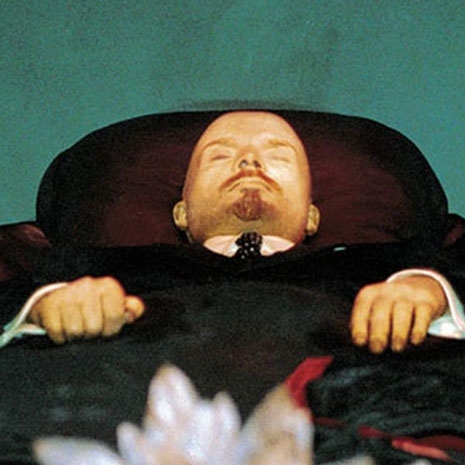
After his death three weeks later, Lenin’s body was embalmed and displayed in the Kremlin Mausoleum, per Stalin’s orders, where it lies to this day, accumulating layers of mortician’s wax with each passing year. Lenin’s baths and maintenance are no longer funded by the government, but continue thanks to public donations. It’s been speculated that it’s this unnatural process that keeps Lenin’s troubled spirit trapped within his Kremlin apartment, which has been locked and sealed for decades. Sounds of restless pacing, shuffling paper and creaking furniture are heard by guards late into the night.
Read the rest of Ghosts of the Moscow Kremlin (Part II) after the jump…
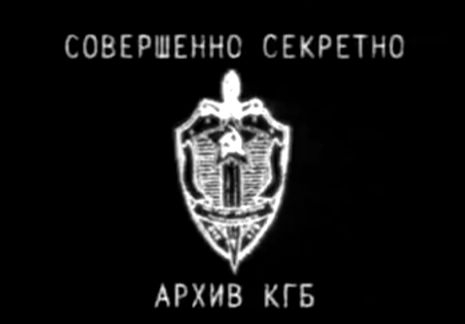
This is a guest post by Zoetica Ebb, a Moscow-born, LA-based artist, writer, photographer and style technician. Follow her on Twitter @zoetica.
Russia in the 80s -when I was growing up there- was bent on things like UFOs, unsolved mysteries and clairvoyants, aka extrasens. Our televisions were bursting with shining lights in the sky and herds of intense, unblinking men demanding we listen to them and LET GO. As a result, I grew up with a vast divide between our regimented atheism and an obvious, nagging hunger for magic. At school, we were taught that communism and Lenin were our sacred cows and that spirituality was stupid. At home and on our summer breaks, we obeyed TV’s orders and scared each other with ghost stories, befuddled by the nation’s inconsistency.
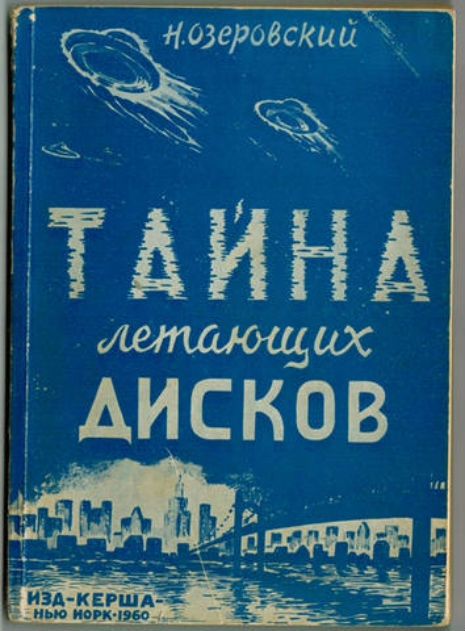
The extrasens thing is especially strange, mostly because of how commonplace they became, regardless of things like educational brackets and class. My own mother – a writer, interpreter and supposed atheist, was cured of bleeding ulcers, not once but twice, at the behest of my grandmother who called an extrasens to the rescue. My grandmother was a forensic pathologist.
It’s not as strange though, if we look back at where Russia comes from. Pagan for centuries, with a rich catalog of ancient folk tales and superstitions, then Orthodox Christian until Lenin and his band of merrymakers took over in the early 1900s. So, it’s no major surprise that so many of my people rabidly jumped on the Orthodox Christianity train the very second Communism fell – it never could quite erase my nation’s innate need for magic.
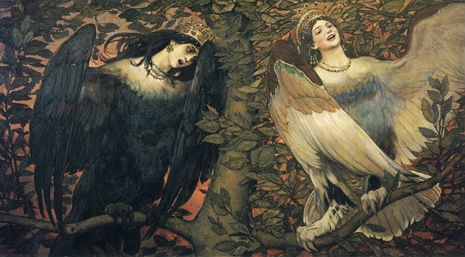
Russian folklore, like most folklores, is teeming with legions of otherworldly creatures. Firebirds, super-humans, undead sorcerers, witches, and enchanted, shapeshifting beauties; some good, some evil, and many somewhere in between. Ghosts, on the other hand, are rare, reserved for those with especially violent deaths or tragic lifetimes – it almost goes without saying that one of Russia’s most haunted locales is The Kremlin.
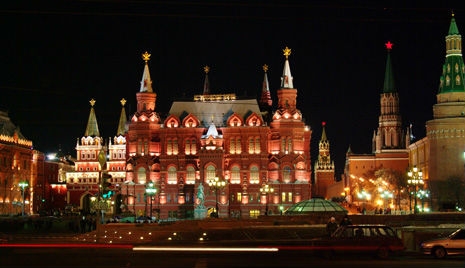
The Moscow Kremlin is a huge fortified complex with four palaces, a bell tower and four cathedrals, surrounded by the Kremlin Wall and Kremlin towers. It’s the official residence of the president of the Russian Federation, the former home of tzars, a place of numerous demonstrations, coronations and executions, and it’s been around for ten centuries. It’s probably fair to assume that, if we’re allowing for the possibility of ghosts, we might as well allow for several thousand of them at the Kremlin. In the interests of concision, though, I’ll outline some of the more famous apparitions seen within its crimson walls.

Ivan the Terrible was the over-achieving, silver-tongued, likely bipolar ruler who conquered and conquered until Russia grew into the enormous country it was through the 21st century. No one did reform like Ivan – whose nickname shouldn’t really be “Terrible”, by the way. In Russian, his name is Ivan Grozny which translates to something between “Ivan the Fearsome” and “Ivan the Formidable”. And he was, ruling for 51 years, and ultimately transforming Russia from a medieval state to a colossal, multi-ethnic empire.
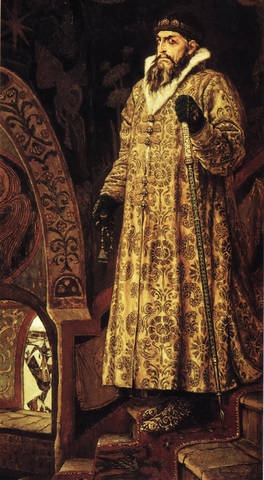
Calling the man “complex” doesn’t come close to doing justice to his numerous assets and eccentricities. When he wasn’t taunting the clergy and aristocracy, demanding absolute power, making leaps in international trading, winning wars, or making babies, king Ivan spent his time writing music, poetry and dry-witted, inflammatory correspondence to his enemies and underlings. Many of these letters exist to this day and have been referred to as “Shakespearean” in their breadth of imagination.
Deadwood fans reading this might liken the mercurial Al Swearengen, at least in part, to Ivan the Terrible.
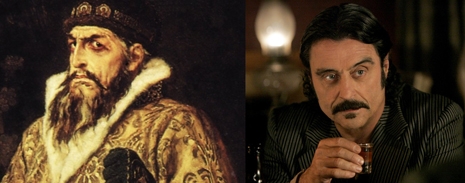
More of Ghosts of the Moscow Kremlin after the jump…

Now over a decade old, Alix Lambert’s The Mark of Cain remains far and away the best prison documentary that I’ve ever seen. Examining Russian inmates and their tattooing traditions, it is a brutal, yet very beautiful, film that brings to mind Dostoevsky’s assertion in The House of the Dead that many of the individuals encountered in the course of his own Siberian stint were among his nation’s most gifted and intelligent. Somehow, in spite of the starvation, overcrowding and violence, an almost perverse atmosphere of high culture pervades this documentary – Tarkovsky’s shadow, for example, is as inescapable as Dostoevsky’s, due not least to the chilling phrase inmates use to refer to prison: The Zone.
Early on we meet Semyon Dyachenko, an otherwise reasonable seeming fellow (and mean tap dancer) imprisoned for decapitating three gypsies who had robbed his mother’s grave.“I have my own laws,” he mumbles through an epic moustache, “if you don’t encroach on what is holy I’ll leave you among the living” (Lambert’s entire cast, by the way, are apparently incapable of uttering a sentence devoid of lyricism). Semyon gestures to a Janus-faced creation tattooed beneath his ribs – half woman, half snarling beast: “It’s called, ‘People are Animals to Each Other,’” he says, unwittingly (?) invoking Man is Wolf to Man, the classic memoir of Soviet brutality by the (now I come to think of it) eerily named Janusz Bardach…
Perhaps the film’s most memorable individual is the young inmate named Aleksandr Borisov, a sublime tattooist who executes his work with a wind-up contraption made out of a razorblade, a ballpoint pen, and a sharpened guitar string (the makeshift ink is derived from a mixture of soot and urine). “This machine, you could say, is my ticket to some kind of life here,” muses dour Aleksandr, before shrugging off his talent in characteristic style: “Leonardo Da Vinci had a special gift… but he didn’t see it, right? A person is a person. I don’t see anything special about me.”
Even the more popular prison tattoos have interesting meanings– the jagged stars on knees symbolise the refusal to kneel down before authority; sailing ships commemorate a roaming life – and the tattooed sentiments tend again to be outright poetic (‘Let all I have lived be as if it were a dream’; ‘A slave to fate but no lackey to the law’). The stunning churches that stretch across torsos and backs, meanwhile, with each cupola standing for a conviction, must be the most laughably Russian phenomenon of all time. As another typically erudite inmate puts it (throwing in a Martin Esslin reference for good measure): “The Zone is a kind of model of the state, only all the relations between people are exaggerated. It resembles the theatre of the absurd.”

Nikolai Alekseev, a Russian gay rights activist arrested during a 2010 Moscow protest (picture above) has been convicted of spreading “gay propaganda” by a court in St Petersburg, making him the first to be convicted under the city’s new anti-homosexuality laws. From Pink News:
Mr Alekseev was said to have been fined 5,000 roubles, just over £100, by a court in Russia’s second city for the promotion of homosexuality among minors, AP reports.
The law was approved in February; this is the first time a citizen has been successfully prosecuted under it.
Mr Alekseev had held up a sign reading “Homosexuality is not a perversion” outside the Smolny Institute in April in public view.
A former journalist, Mr Alekseev turned his attention to full-time gay rights campaigning in 2005, setting up the gay rights advocacy group GayRussia.ru.
He has appeared regularly on Russian television and has been honoured for his work by LGBT organisations worldwide.
He has been arrested on numerous occasions for holding illegal Pride marches and gay rights demonstrations and launched lawsuits against Moscow authorities for banning the events and had announced his intention to retire last year.